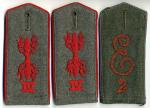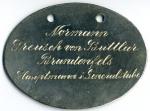-
Posts
2,962 -
Joined
-
Last visited
Content Type
Profiles
Forums
Blogs
Gallery
Events
Store
Everything posted by Chip
-
Hello I.G., The older guy is wearing the cross on his cap, because he was probably in the reserve before the war, the other crew members are most likely wartime recruits and therefore did not get these. At least that would be my explanation. I think the first word is "Ostzug" and "5/Res.3" is the 5th battery of the regiment. The regiment was raised in August of 1914. Chip
-
Well, it appears that the shoulder strap is that of the Telegraphentruppen. It has a red "Blitzbundel" with the battalion roman numeral underneath. Of course, the shako was worn by the Telegrapentruppen too. This is a well-known photo card that was distributed as part of a general series of wartime photo postcards. The wording means that the post was connected to the artillery battery via telephone. The handset is call Armeefernsprecher a.A., which is connected to, I beleive, a Sprechbatterie a.A.. Chip
-
Over the years I have managed to find Erkennungsmarken with neck cords in the state colors. One that has eluded me is a Saxon example. They must have existed, but I have never seen one. If someone has a Saxon piece, I would love to see it. I was also wondering if other state examples exist, especially neck cords with the Mecklenburg colors. Chip
-

EK 1914 The EK1 in wear...
Chip replied to Chris Boonzaier's topic in Germany: All Eras: The Iron Cross
Me too Hardy! :jumping: -
It is quite possible that enlisted pioneers were still wearing gray shoulder straps later in the war, especially on the simplified wartime pattern tunics (exposed button fronts). The black straps were authorized in 1915, but the previous patterns continued to be worn on tunics that were already issued. It would have been a slow process to outfit the older tunics with the new shoulder straps (if it was done at all). The first priority was getting them on the Blusen that were coming out of the factories for new recruits, for replacement of unserviceable tunics, etc.. Here is the M1907 enlisted pattern strap for the Garde Pioniere. The simplified version was similar, but without the red piping and attaching tongue on the reverse.
-
Regarding unofficial insignia, I would agree that there were many things worn that are not well known. There are others that are very well known and existed on a divisional level for some time, despite specific warnings from the highest authorities. If these were allowed to be worn (such as the sleeve insignia of the 208."Querstrich" Division), then who's to say that others were not worn on a smaller scale? Further little known examples are all of the "specialty" sleeve patches worn within the infantry regiments once they were expanded to include their own Minenwerfer, Nachrichten and pioneer specialists. As we know, there were even special "Sturmtrupp" insignia within regiments and divisions. I have an example of one of these and photos showing a similar insignia being worn during a field award ceremony that was attended by the crown prince. I have never seen it anywhere else. If I had not found the photos along with the insignia, no one would have believed that it was authentic. There are many more examples that I could list which were worn and tolerated at some level. So I guess my point is that we don't know it all and most likely never will...but, I think it is still OK to be skeptical about things until they are proven. On the other hand, it is OK to have unsubstanciated opinions as well. I know I harbor some. Chip
-
My question about Thomas' photo is, if this is a black skull, why is it not darker? The only shots that sort of look like a skull are enhanced versions. In the original photo it is nearly impossible to see. The ends of the bread bag strap around his neck are of brown leather. They show up very darkly. One would think a black skull would show up even darker. There may well be a skull there, but I don't know how it could be black. Chip
-
For anyone interested in the subject of German WWI Erkennungsmarke, there is a nice book on the subject by Peter Meinlschmidt. It is available with English or German text.It covers the background history, regulations, unit markings, with a large section of examples. The English title is, "German WW1 Identity Tags/Disks". Copies may still be available from the author. The last address I have for him is, Peter Meinlschmidt, Bärenacker 12, Düngenheim, Germany. Chip
-

Rare uniforms
Chip replied to The Prussian's topic in Germany: Imperial Uniforms, Headwear, Insignia & Personal Equipment
Andreas, It might be a woven "double ribbon". You could buy combinations of different ribbons that were woven on one normal size ribbon. For example,





